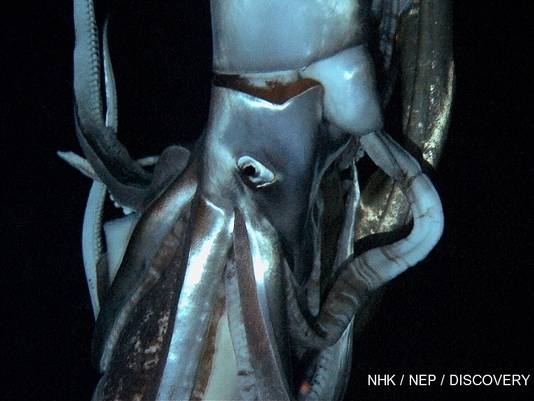Giving hope to all who search for Cryptids the Architeuthis, also known as Giant Squid is now on camera. Once relegated to “fish stories” brought home by sailors going back to Aristotle, architeuthis has been known known to exist based upon dead specimens and body parts that wash up on beaches since the mid 19th century. For all that time they have kept themselves in hiding in the ocean depths, hunted by sperm whales who dive into the darkness to find them finally a confirmed live specimen has been observed in its natural habitat.

From USA Today
Scientists have filmed the first views of the giant squid, a mild monster of the deep sea.
Dan Vergano, USA TODAY9:40a.m. EST January 25, 2013Kraken. Devilfish. Giant squid. One of the mysterious inhabitants of the deep ocean gets its close-up this weekend, seen for the first time alive and in its natural habitat.
Sought by scientists for centuries, the views of giant squids, creatures about 40 feet long dwelling in the deep ocean, arrive Sunday in Monster Squid: The Giant is Real, on the Discovery Channel (8 PM ET/PT). Underneath the excitement of the long-sought sea monster appearing alive is a serious scientific story, say the researchers who helped capture the first film views of the undersea creatures.
“Our first few glimpses were amazing, almost like the squid was teasing us,” says bioluminescence expert Edie Widder of Ocean Research and Conservation Association in Fort Pierce, Fla. “Then we definitely saw we had the right animal, those huge eyes.”
VIDEO
Produced with Japan’s NHK network, the show recounts the travails of three scientists, Widder, biologist Steve O’Shea of the Auckland University of Technology in New Zealand, and Tsunemi Kobodera of the National Science Museum of Japan, as they hunt for the first glimpse of a living giant squid in the Pacific Ocean off Japan. Made famous in the public mind by Jules Verne’s 1870 book, 20,000 Leagues Under the Sea, tentacles and carcasses of the creatures have washed ashore and into fisherman’s nets for decades, but the squids had never before been seen alive, until now.
The public got an advance peek of the creature in a video clip from the show posted on YouTube that went viral earlier this month.
Like all squids, giant ones have eight arms, two feeding tentacles and a cap-like mantle. Giant squids are distinguished by their length, perhaps as much as 40 feet in females, with a mantle six feet long and eyes the size of cantaloupes. They dwell perhaps 300 to 3,000 feet underwater, turning their gaze upward to search for prey, even as they fall prey themselves to sperm whales.
“If they are monsters, they are very gentle ones,” says squid expert (or teuthologist) Clyde Roper of the Smithsonian’s Museum of Natural History in Washington, D.C. Roper organized unsuccessful expeditions in the late 1990s hunting for deep-sea views of giant squids off New Zealand, and he delivers one of the more delightful moments of the show as he happily confirms to the scientists that they had succeeded in capturing the first camera shots of a living giant squid.
“It’s important for people to see this kind of science, seeing living creatures as they actually live, where they actually live, is still important,” Roper says. “It’s not all genes and computers, but every kind of science working together.”
Or not. The show has some fun with the scientists as they set out on their quest, trying out competing squid lures, failure dogging their every step as they seek out the giant squid. Aboard a bubble-topped three-man Triton submersible (“luxurious compared to a lot of things I’ve dived in,” Widders says), they eventually spent 285 hours in the depths on 55 sub dives, many more than 3,000 feet down in search of their quarry.
Their eventual success shows that luring the hidden denizens of the deep with bait and glowing lights that mimic prey might represent a better approach to documenting the creatures, instead of hunting them out in subs with bright lights blazing. “We’ve been exploring the deep ocean the wrong way, scaring them off instead of drawing them in,” says Widder, who employed a lure that mimics the bioluminescent lights of the glowing Medusa jellyfish on the expedition.
Bioluminescence, or light given off by living things, is seen in everything from fireflies to fungi, but plays a key role in creatures in the deep ocean, where glowing lanternfish and jellyfish are plentiful. Those jellyfish are preyed upon by smaller squids, which in turn are fed upon by giant squids. So, on the dives, Widder turned on her lure’s lights in a bid to entice a giant squid to come prey upon a jellyfish predator.
“Those huge eyes, living in perpetual darkness, clearly they pick up on bioluminescence above them,” Roper says. Although an electronic bioluminescence device that mimics the panic signal of a jellyfish first attracts a giant squid on the show, the longest encounter with one comes courtesy of plain old bait, a smaller squid, which entices the creature to hang around for extended observation. “It’s wonderful to be part of something scientifically successful,” Widder says.
What’s next? Well, she would like to try for observations of the colossal squid, the only one larger than a giant squid. Only discovered in the 1920s, colossal squid live in the Antarctic Ocean and grow to perhaps 46 feet in length. “In a heartbeat I’d go look for them,” Widder says. “It has bioluminescent eyes. That is something I’d like to see.”
While there is a lot more ocean left unexplored, and who knows what could be lurking there, it does leave some hope of discovery of a few of the more probable land dwelling cryptids that their deep ocean cousin has finally revealed itself.
1 comment




